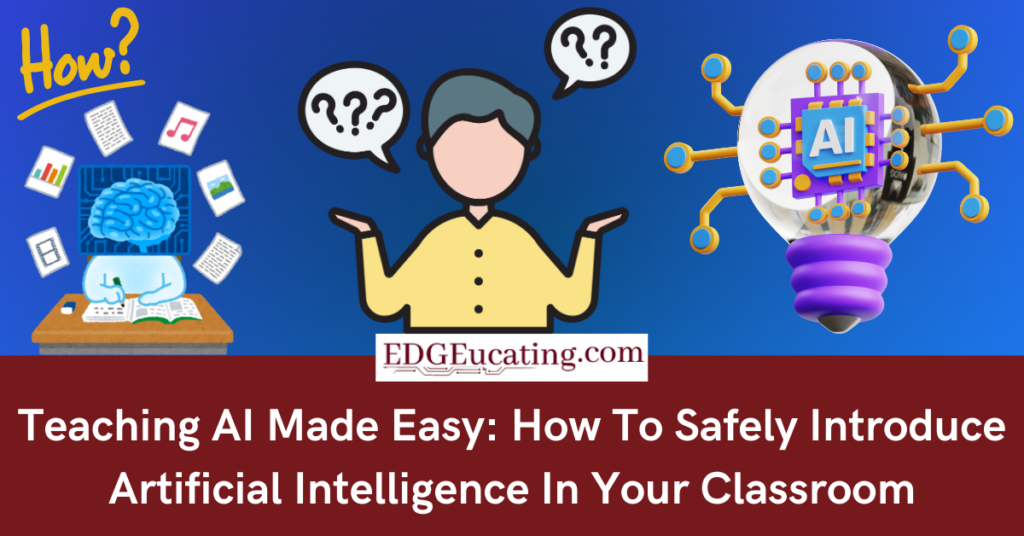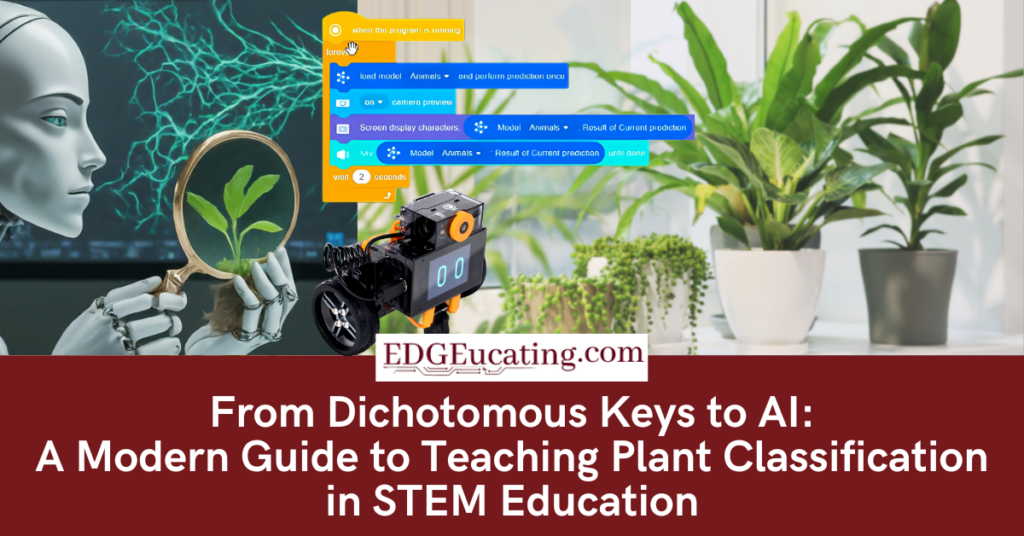Artificial intelligence (AI) is rapidly becoming an integral part of our world, transforming industries and shaping the future. In education, AI is increasingly connected with STEAM education, giving students opportunities to merge science, technology, engineering, arts, and math in meaningful ways. As educators, it’s essential to prepare students for this AI-driven landscape by equipping them with the knowledge and skills to thrive. However, the thought of integrating AI into your classroom can seem overwhelming, especially with concerns about complexity and data privacy. The good news is that teaching AI doesn’t have to be complicated or risky. With the right tools and strategies, you can make AI education both accessible and secure.
This guide introduces a range of user-friendly AI educational tools that make teaching AI concepts easy and engaging, allowing you to confidently bring the power of AI into your classroom.
Why AI Education Matters
Before diving into the tools, it’s essential to understand why AI in education is crucial:
- Preparing for Future Careers: AI is revolutionizing industries and job markets. Early exposure to AI helps students develop the skills they’ll need in future careers, especially when integrated into STEAM education, making them more adaptable and innovative thinkers.
- Encouraging Problem-Solving: Learning AI concepts enhances students’ analytical abilities and fosters creative problem-solving skills.
- Demystifying Technology: Teaching AI in a controlled, educational setting helps students understand the technology that impacts their lives, reducing fear and promoting responsible use.
Given these benefits, teaching AI is a vital step toward future-proofing your students’ education.
Selecting the Right AI Tools: Prioritizing Ease and Security
When choosing AI tools for your classroom, it’s essential to prioritize tools that are easy to use, secure, and engaging. According to the article “From Frustration to Innovation: EdTech Evaluation Tips for the Classroom,” evaluating EdTech tools requires considering factors like user-friendliness, curriculum alignment, and data privacy. Look for tools that simplify complex concepts and maintain a strong focus on protecting student information.
Below are several educational tools for teaching AI that meet these criteria, making AI education straightforward and secure.
Umety: Bridging AI and Cybersecurity
Overview: Umety is a comprehensive platform that integrates AI education with cybersecurity, offering students a unique opportunity to explore the intersection of these critical fields. It also supports STEAM education by connecting AI learning to broader cross-disciplinary projects. Beyond foundational AI concepts, Umety provides Career Exploration Videos that introduce students to various tech careers, including Information Security Analysts, Web Developers, Blockchain Analysts, and Artificial Intelligence Engineers. These resources are designed to align with specific learning objectives, helping students understand the real-world applications of AI and cybersecurity.
Why It’s Easy and Safe: Umety’s structured modules and interactive simulations make learning both accessible and engaging, while the platform’s secure environment ensures that student data is protected throughout the educational experience.
Classroom Application: Utilize Umety to simulate real-world cybersecurity scenarios where students can act as analysts, detecting and mitigating cyber threats using AI tools. Incorporate Career Exploration Videos to deepen students’ understanding of potential career paths in technology, linking classroom learning to future opportunities. The guide provided by Umety outlines specific learning objectives for each career, allowing educators to tailor lessons that are both informative and inspiring.
CoDrone EDU: Learning AI Through Flight
Overview: CoDrone EDU introduces students to AI concepts via programmable drones equipped with various sensors, making learning about AI tangible and exciting. The Ecosystems Middle School Unit offers a comprehensive lesson plan that ties drone technology to environmental science, integrating AI with ecosystem studies.
Why It’s Easy and Safe: CoDrone’s block-based coding and real-time feedback make programming accessible for beginners, and its secure, classroom-contained operation ensures student privacy.
Classroom Application: Use the Ecosystems Middle School Unit to have students program drones for environmental monitoring, teaching AI decision-making, and its role in ecosystem management.
Kai’s Clan: Collaborative AI Adventures
Overview: Kai’s Clan offers an interactive platform where students can program robots to navigate both physical and virtual environments, blending coding, robotics, AI learning and STEAM education experiences. The Kai’s Clan Playbook provides a wealth of free resources and lesson ideas to help you integrate this tool into your classroom effectively.
Why It’s Easy and Safe: Kai’s Clan’s collaborative, AR-enhanced learning experiences are intuitive and engaging, with all data managed securely within the classroom network.
Classroom Application: Use the Kai’s Clan Playbook and their free online platform, which includes a large lesson repository, to guide students through missions where robots must solve real-world problems, such as disaster response or environmental clean-ups, helping them learn AI navigation and sensor integration.
Pi-top: Building AI-Powered Solutions
Overview: Pi-top provides modular hardware and software that allow students to build and program their own AI devices, such as smart home systems or environmental monitors. Pi-top’s design focuses on making AI education straightforward, with comprehensive tutorials that guide students through the learning process.
Why It’s Easy and Safe: Pi-top’s modular design and guided tutorials make learning accessible, and its offline functionality enhances security by eliminating the need for internet connectivity.
Classroom Application: Guide students in creating AI-powered smart home systems that respond to environmental changes, teaching machine learning and the Internet of Things (IoT). Use these projects to discuss the ethical implications of AI, encouraging critical thinking.
Strawbees: Creative AI Exploration
Overview: Strawbees allows students to construct and program interactive models and machines using simple connectors and straws, integrating AI concepts in inventive ways. This platform encourages creativity while providing a secure, hands-on learning environment.
Why It’s Easy and Safe: Strawbees’ use of everyday materials and visual programming interfaces makes it accessible for young learners, with activities conducted in a secure, offline setting.
Classroom Application: Have students design and program AI-powered creatures that respond to environmental stimuli, teaching them about AI’s role in sensory processing and decision-making. Classroom challenges can also foster problem-solving and iterative design skills.
Hummingbird: Customizable Robotics and AI
Overview: Hummingbird kits allow students to build and program robots with diverse functionalities, providing a flexible platform to explore various AI applications. The Equitable Playgrounds for All lesson outline offers an example of how to use Hummingbird kits to address real-world challenges, such as designing inclusive playgrounds.
Why It’s Easy and Safe: Hummingbird’s flexible design supports a range of projects, making it adaptable to different learning levels. Its security and local execution ensure data privacy.
Classroom Application: Challenge students to design AI-powered solutions for creating inclusive playgrounds using the Equitable Playgrounds for All lesson plan, fostering both technical and empathetic skills. Encourage students to create assistive robots that perform practical tasks, teaching them about the real-world applications of AI.
Boxlight Labdisc: Exploring AI in Science
Overview: Boxlight Labdisc is a portable lab device that integrates AI into various scientific experiments across disciplines like biology, chemistry, and physics. This tool simplifies data collection and analysis, making bringing AI into your STEM curriculum easy.
Why It’s Easy and Safe: Labdisc’s all-in-one design simplifies the learning process, while its secure data management ensures all experimental data remains protected within the classroom.
Classroom Application: Conduct experiments where students use AI to analyze environmental data, such as predicting weather patterns or monitoring air quality. Labdisc helps students explore the intersection of AI and science, making abstract concepts more tangible.
Matatastudio Nous AI Bot: Early AI Education
Overview: The Matatastudio Nous AI Bot is an innovative educational tool designed to introduce middle school students to AI and STEAM education concepts through hands-on learning. Its programming platform, MatataCode, supports both graphical and Python programming, making it adaptable to various learning levels. In addition to basic coding, MatataCode allows students to explore advanced AI functions such as computer vision and embedded machine learning (Tiny ML), providing a comprehensive introduction to AI in a fun and accessible way.
Why It’s Easy and Safe: MatataCode’s dual programming options—graphical for beginners and Python for more advanced learners—ensure that students can engage with AI concepts at their own pace. The platform’s secure offline operation keeps the learning environment safe and controlled.
Classroom Application: Start by familiarizing students with MatataCode’s features, including firmware upgrades, connections, and program downloads. Then, guide them through writing simple programs using the graphical programming interface to control Nous. As students gain confidence, they can explore more complex AI functions like computer vision and Tiny ML. These activities not only teach essential programming skills but also introduce students to the broader possibilities of AI technology. For a deeper understanding of how the Nous AI Set works in the classroom, check out this video demonstration as well as this article that I wrote titled From Dichotomous Keys to AI: A Modern Guide to Teaching Plant Classification in STEM Education.
Oti-Bot: Interactive AI Lessons
Overview: Oti-Bot is an engaging educational tool designed to introduce students to the fascinating world of AI through interactive and hands-on activities. It offers a robust platform for teaching fundamental AI concepts such as pattern recognition, obstacle navigation, and basic machine learning. Oti-Bot is particularly effective in bringing AI concepts to life, making them accessible and exciting for students of all ages.
Why It’s Easy and Safe: Oti-Bot’s intuitive interface and user-friendly design make it easy for students to program and interact with the robot, ensuring a smooth learning experience. The platform is built with classroom safety in mind, providing a secure environment for students to explore AI without concerns about data privacy.
Classroom Application: With Oti-Bot, students can engage in a variety of educational activities, such as programming the robot to navigate obstacle courses, recognize and sort objects, or respond to environmental cues. These exercises not only reinforce coding and problem-solving skills but also provide a practical introduction to how AI operates in real-world scenarios. By using Oti-Bot, educators can create a dynamic learning environment where students gain hands-on experience with AI, fostering curiosity and innovation.
Explore how Oti-Bot can transform your classroom and introduce students to AI in an interactive and secure way. Discover more about its applications in education here.
Code-a-Pillar: Introducing AI to Early Learners
Overview: The Code-a-Pillar Twist is an engaging and age-appropriate tool designed to introduce young children to the foundational concepts of AI and coding. By connecting segments of the Code-a-Pillar in different sequences, early learners can explore cause-and-effect relationships, sequencing, and basic problem-solving—all essential building blocks for understanding AI. As highlighted in the ISTE article on AI literacy and digital citizenship, starting AI education early helps demystify technology and fosters critical thinking from a young age, laying a foundation for future STEAM education.
Why It’s Easy and Safe: Code-a-Pillar’s tactile and visual approach to learning makes complex ideas accessible to young minds. The product is designed for safe, offline play, ensuring a secure environment for exploration without concerns over data privacy.
Classroom Application: Use Code-a-Pillar to teach sequencing and logic by having students arrange the segments to guide the robot through specific paths. This activity introduces the basics of coding and AI logic in a way that is both fun and educational. Additionally, incorporating Code-a-Pillar into lessons on digital citizenship helps students understand how technology works, laying the groundwork for more advanced AI concepts as they progress in their education.
Ideamapper: Visualizing AI Concepts
Overview: Ideamapper is a mind-mapping software that helps students visualize and organize complex AI concepts, facilitating better understanding and retention. It’s a valuable tool for both individual and collaborative learning, providing a secure platform for developing and sharing ideas.
Why It’s Easy and Safe: Ideamapper’s visual learning approach makes complex information more accessible, and its secure platform protects user-generated content.
Classroom Application: Have students create concept maps that outline different AI applications across industries, helping them connect classroom learning to real-world technology. Use Ideamapper for project planning, enhancing organization, and critical thinking skills.
Simple Starters for AI Literacy and Digital Citizenship
To support your efforts in AI education, consider integrating foundational lessons on AI literacy and digital citizenship. The ISTE article on simple starters for AI literacy provides a practical approach to teaching these crucial topics. It emphasizes the importance of helping students understand AI’s role in their lives and the broader society, making them informed digital citizens.
Additional Resources for AI Education
To further support your AI teaching journey, consider these valuable resources:
- 10 Essential AI Tools for Educators: This article provides a curated list of additional AI tools that are both effective and educator-friendly, offering more options to diversify your teaching methods.
- Careers in STEM: This platform connects classroom learning with real-world career pathways. The Careers in STEM Explorer platform includes dozens of AI-related careers, such as AI researcher, data analyst, software engineer, and many more. It offers lessons and activities that showcase AI-related careers and inspire students to envision their future in tech.
Conclusion: Embracing AI Education with Confidence
Teaching AI in your classroom doesn’t have to be overwhelming or risky. You can make AI education easy, engaging, and secure with the right tools and resources. These platforms simplify complex concepts and ensure your students’ privacy and safety are always prioritized.
By embracing these accessible AI teaching solutions, you’re empowering your students with critical skills that will serve them well in an increasingly technology-driven world. Pairing AI with STEAM education ensures students not only gain technical knowledge but also creativity, collaboration, and design-thinking skills.
Ready to transform your classroom by teaching AI? Explore these tools and resources, and take the first step toward future-proofing your students’ education.



